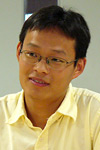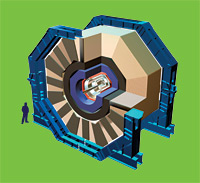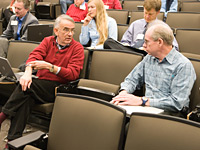China Engages in Large-Grain Niobium Single Cells

Xu Qingjin stayed at KEK from 5 June to 2 September to build large-grain niobium single-cells and learn about surface treatments. |
In the International Linear Collider (ILC), superconducting cavities made of niobium will be used. Niobium is a superconductor - a material that loses its electrical resistance when cooled down to almost absolute zero. Clean and extremely smooth cavity surfaces are essential for achieving a high accelerating gradient. Manufacturing cavities from large-grain or single-crystal niobium may cut down expenses by eliminating some of the treatments that are necessary for fine grain cavities. Therefore the quality of the niobium becomes one of the most important points of cavity manufacturing. CBMM from Brazil, W.C.Heraeus from Germany, and Ningxia from China are the world leaders in niobium treatment.
Read more...
-- Nobuko Kobayashi |
|
 |
ILC Detectors in the Making: Silicon Detector (SiD)
In July, ILC NewsLine provided an overview of the Global Large Detector (GLD) concept. This week's issue takes a closer look at the Silicon Detector (SiD) concept. ILC NewsLine will continue its series about the four ILC detector concepts in the weeks to come. Next: Large Detector Concept (LDC).

Artist's rendition of SiD.
(Courtesy of SLAC) |
Standing at 12 metres tall, 12 metres wide and 12 metres deep, the Silicon Detector (SiD) is a compact International Linear Collider detector concept. As the only detector concept to use silicon technology exclusively for particle tracking and calorimetry, naming this detector concept SiD seemed very natural for the international collaboration of approximately 150 scientists. Silicon technology is an expensive commodity, however, making it important to keep the detector as small and cost effective as possible.
Read more...
-- Elizabeth Clements |
 |
|
|
 |
From Chicago Sun Times
24 October 2006
Fermilab gets charge out of new particles
Nature's zoo of subatomic particles just got more crowded. Physicists at
west suburban Fermilab on Monday announced the discovery of two exotic
particles that haven't been around much since the first few moments
after the universe began with a Big Bang.
Read more... |
|
From The New York Times
20 October 2006
The Universe on a String
...Nevertheless, mathematical rigor and elegance are not sufficient to
demonstrate a theory's relevance. To be judged a correct description of
the universe, a theory must make predictions that are confirmed by
experiment...
Read more...
(Registration required) |
|
From Physorg.com
October 2006
New experiment to investigate cosmic connection to clouds
A novel experiment, known as CLOUD (Cosmics Leaving OUtdoor Droplets),
begins taking its first data today with a prototype detector in a
particle beam at CERN, the world's largest laboratory for particle
physics...
Read more... |
|
From Nature
18 October 2006
Japan's new premier chases innovation
Prime minister breaks with tradition to appoint scientist as special adviser.
Read more...
(Registration required) |
|
From CERN
2006
LHC - The Guide
CERN has just published a fact book about the LHC. The first version is
available in PDF. |
|
|
 |
ILC-Americas Regional Team Looks to the Future
Today's issue features a Director's Corner from Gerry Dugan, GDE Americas Regional Director.

Paul Grannis (left) of the DOE and Gerry
Dugan during last week's Linear Collider Forum of America meeting at
Fermilab. |
Over the past year, in addition to contributing to the ILC Reference Design Report, the ILC-Americas regional team (ART) has focused on programme planning for the next few years. We anticipate that this time period will roughly correspond to the period when an engineering design of the ILC will be carried out, and when the key R&D questions, which require answers prior to project approval, will be confronted and resolved.
Read more...
-- Gerry Dugan
Director's Corner Archive |
 |
|
|
 |
LBNL’s Mike Ronan Remembered for Hard Work, Versatility and Enthusiasm

Michael Ronan |
Senior Scientist Michael Ronan, who spearheaded a Time Projection Chamber design for the International Linear Collider and served as the Americas representative for the Global Large Detector collaboration, died on 17 October 2006. He was 57.
"On behalf of the ILC community, I want to express our profound sadness and sense of loss over the death of Mike Ronan," said GDE Director Barry Barish. "Mike was a colleague and a brilliant experimentalist, who had made a deep commitment to the ILC. Perhaps someday we will be recording collisions in a time projection chamber, just as Mike had envisioned."
The UC Berkeley Physics Department held a special ceremony for Ronan on Tuesday, 24 October. A mass was held on 23 October at St. Joseph's Catholic Church, Pinole.
Read more about Ronan's life in an obituary published Tuesday by Today at Berkeley Lab.
-- Elizabeth Clements |
 |
|
|
 |
|
ILC-Related Preprints
hep-ph/0610297
23 Oct 2006
Study of the singly charged Higgs in the economic at 3-3-1 model at e+ e- colliders
physics/0610145
19 Oct 2006
The Impact of BeamCal Performance at Different ILC Beam Parameters and Crossing Angles on  searches searches
physics/0610059
10 Oct 2006
Triple-GEM performance in He-based mixtures |
|

